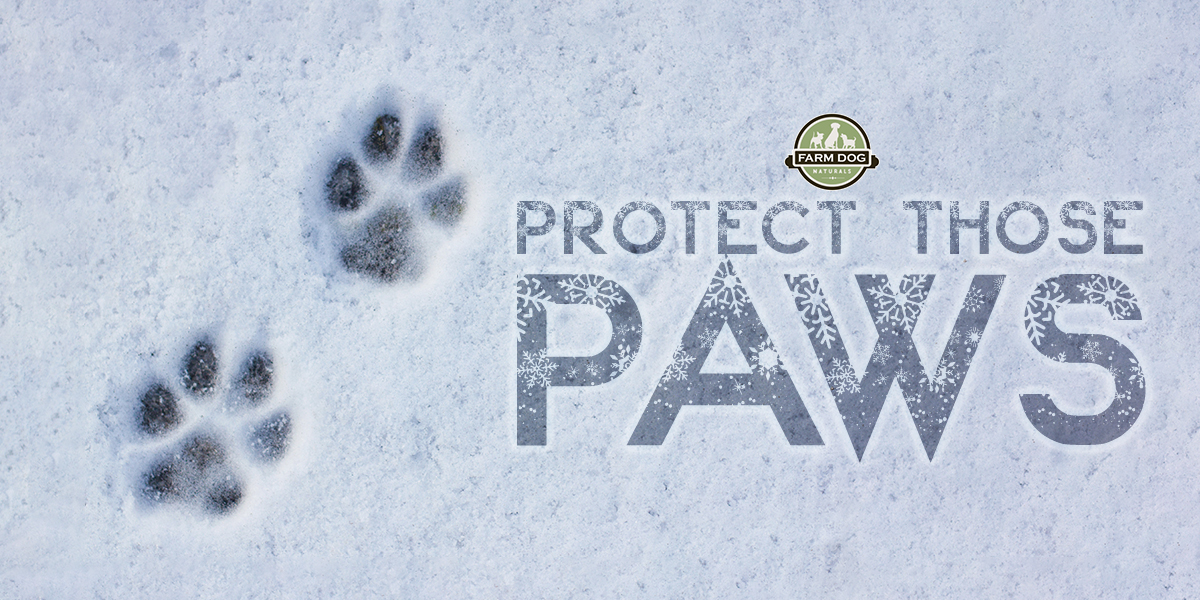With winter weather upon us in many areas, we’re loving all the pictures we’re seeing lately of dogs enjoying that first romp in the snow. The joy on their faces as they plow through the snow piles, rolling in the soft, cool fluffy stuff, or racing to catch each snowflake before it hits the ground.
But, it also reminds us for the dire need for winter paw protection for our canine companions. While the snow in the backyard may not pose much risk, other areas can be a bigger problem. Keeping those little paws safe over the winter is so important.
Thankfully, there are several easy ways to do that!
But first, why is this so important?
Winter Risks
Why is winter paw protection so crucial? There are a few reasons.
Firstly, when ice builds up, or snow gets trapped in the fur around your dog’s paws, walking can actually hurt! Snow and ice can even increase your dog’s risk of frostbite if it’s cold enough! Our dogs’ paws may be tough, but that doesn’t mean they’re totally cold and ice resistant.
The ice and cold can also dry out paw pads, leaving the skin chapped or cracked. Cracked paws can be annoying and painful, and many dogs will lick at painful paw pads, which can lead to other issues.
But that’s not the biggest risk.
The salt and de-icer used on sidewalks, roads, and walkways are loaded with chemicals. Many of these chemicals are actually strong enough to cause chemical burns to your dog’s paw pads. And, if your dog licks at her paws after a walk, they can cause indigestion or other GI issues.
As you can see, protection is a must!
Tips for Winter Paw Protection
When it comes to winter paw protection, these tips can’t be beat!
1. Booties!! If your pup will wear them, booties will do the best job of protection sensitive puppy feet. Booties can reduce or eliminate contact with harsh salt or chemicals and prevent snow, ice, and salt or sand from getting stuck between her toes.
Tips: Only use boots that fit properly. Properly fitting boots stay in place when your dog walks or runs, but aren’t so tight they change your dog’s natural stride. Find ones with grips that make it easy for your pup to traverse the ice. Give your dog time to get used to them by having her try them on and walk around in them in the house. Use lots of encouragement and treats!
2. A Pawdicure. Make sure your dog’s paws are winter-ready. Long fur around the paws attract the snow and ice (other of course those chemicals). Trim any longer fur around your dog’s paws to make it harder for bits of ice, salt crystals, or ice-melting chemicals to dry and cling to her skin.
3. Avoid the Use of Chemicals. While we can’t control what the city or town uses for ice on the roads, we can control what we use at our own homes. Avoid harsh deicers and chemical snow melts. Shovel routinely to help prevent ice build up (thus, reducing the need for a de-icer).
4. A Good Wipe Afterwards. After a walk, we always have our dogs walk through fresh/clean snow to help remove some of the salt/chemicals, but that’s often not enough (or sometimes not an option). When you get inside, give those paws a thorough wipe. Warm (not hot) water on a rag will remove most (if not all) of the problematic contents, and will help melt any snow or ice build up.
5. Hydration Station. As mentioned, the ice, snow, and chemicals dry out those paw pads, so you want to give them a little TLC. You want to find something with natural ingredients, something that’s soothing and can help moisturize and heal dry, cracked paws and even protect them from getting to that point! We recommend our Salvation Salve!
The winter can do a number on our dogs’ paws, so a little winter paw protection is always in order. These tips make it easy, and your dog will thank you!

